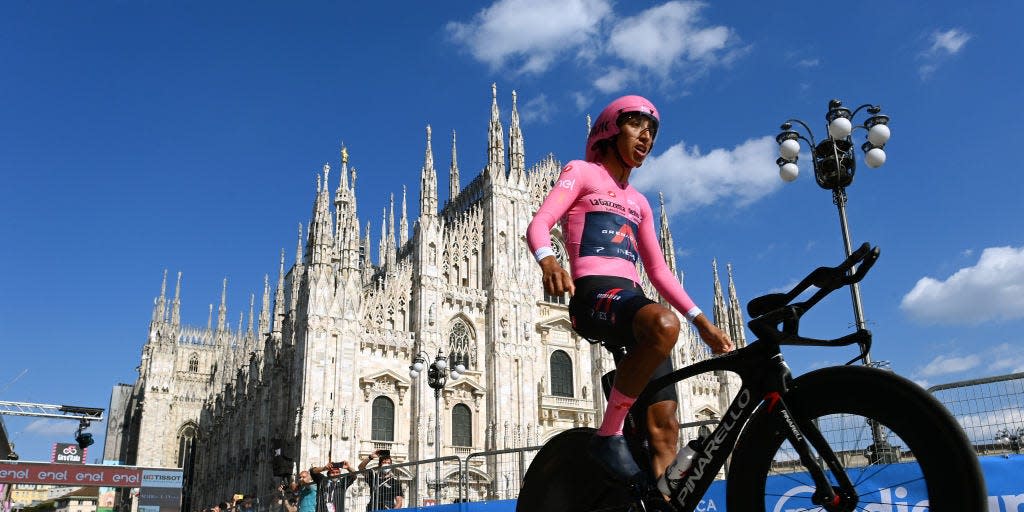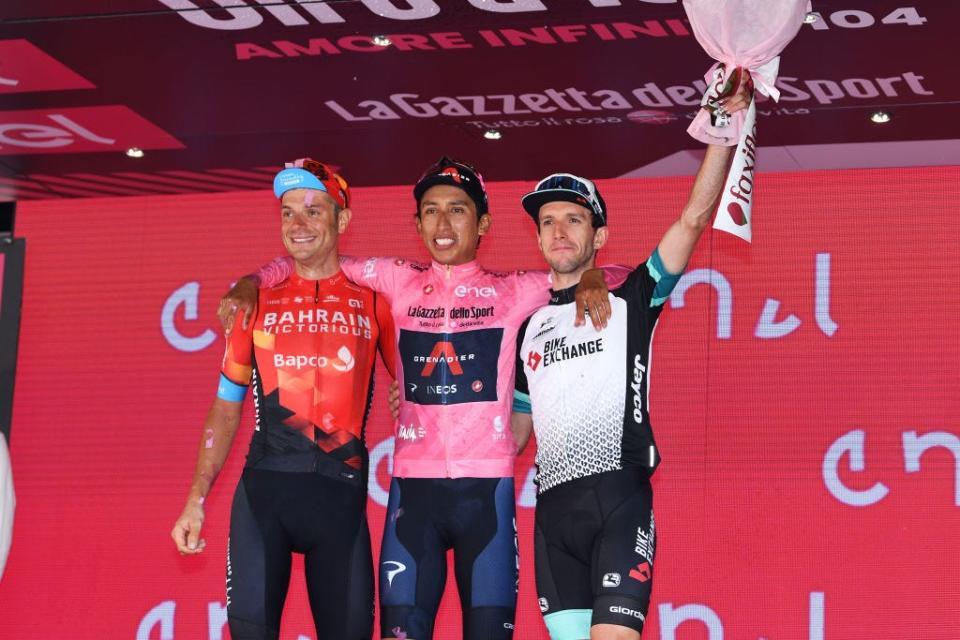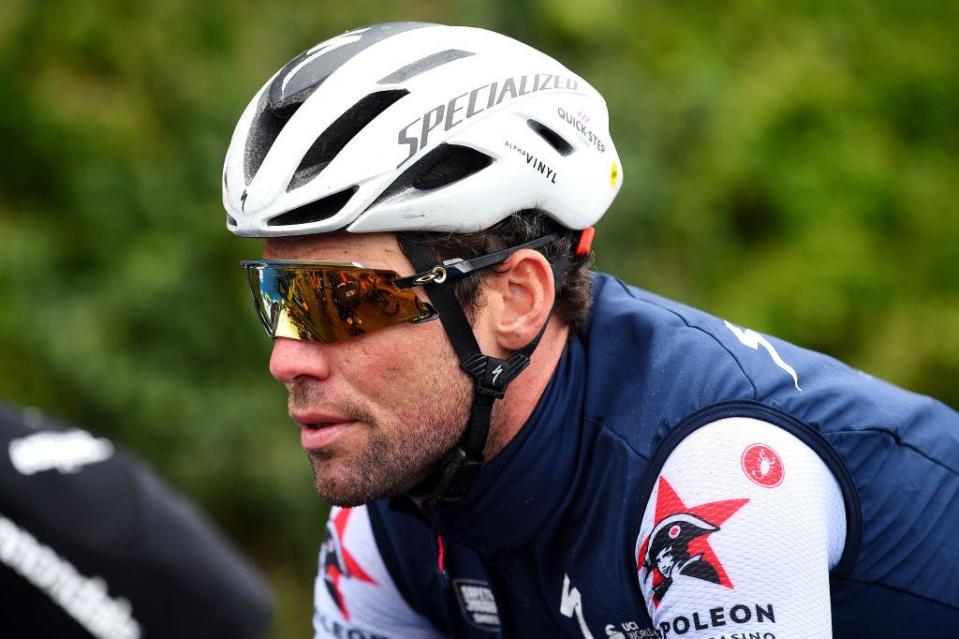Everything You Need to Know About the 2022 Giro d’Italia

It’s May, which means it’s time for one of the sport’s hardest races in one of the world’s most beautiful locations: the Giro d’Italia, the first of pro cycling’s trifecta of three-week “Grand Tours.”
Here’s everything you need to know about this year’s race, from the route to its history to the riders to watch and predictions for 2022.
What: The 2022 Giro d’Italia
When: Friday, May 6 - Sunday, May 29
Where: Stage 1 begins in Budapest, Hungary, and ends in Verona, Italy.
How to Watch: A subscription to GCN+ ($8.99/monthly or $49.99/yearly) gets you the entire Giro d’Italia, both live and on-demand via the web, the GCN+ iOS app, and the GCN app for Amazon FireTV, Roku, and Apple TV.
You could cancel your monthly subscription at the end of the race, but GCN+ also offers live streams of many more road races throughout the summer and cyclocross throughout the fall and winter, which makes the $49.99 annual subscription a terrific value for fans in search of a reliable (and legal) way to stream many of the season’s best events.
Course preview
Overall, the 2022 Giro d’Italia covers 3,410km (2,114 miles) spread over 21 stages, with two individual time trials, six mountain stages (four of which end with summit finishes), six “hilly” stages that look perfect for breakaways, seven days that should end in field sprints, and three rest days.
The race opens with three stages in Hungary, starting with a 195km road stage from Budapest to Visegrád on Friday, with an uphill finish that should make for an exciting sprint. Stage 2 brings the Giro’s first individual time trial (ITT) with a 9.2km city circuit that visits both Pest and Buda on either side of the Danube. Stage 3 covers 201km from Kaposvár to Balatonfüred with a flat finish that should produce the first pure field sprint of the race. A Monday Rest Day gives the race a chance to fly from Hungary to Sicily, where two stages await including a Stage 4 summit finish on Mount Etna, the first of this year’s four mountaintop finishes.
The race then works its way north with three tough stages at the end of the Giro’s first week: Stage 7, a lumpy stage with four categorized climbs and almost 4,500 meters of elevation gain; Stage 8, a short stage with five hilly finishing circuits around Naples; and Stage 9, a high mountain trek through the Apennines that ends with the climb to Blockhaus, one of the longer, steeper climbs in this year’s Giro. By the summit, the Giro’s real contenders should emerge.
The second week begins along the Adriatic coast and heads north and then west through Emilia-Romagna for Stages 10 and 11. Stage 12 begins in Parma and ends along the Mediterranean in Genova; Stage 13 starts in Sanremo, a town known for hosting the finish to the season’s first one-day Monument, Milano-Sanremo. On paper, these stages should favor sprinters and breakaway specialists.
The real action should come on Stages 14 and 15, which close the Giro’s second week. Stage 14 takes the riders on a short but intense ride from Santena to Trentino, with two-and-a-half laps of a challenging circuit featuring five categorized climbs. Stage 15 brings the race into the Western Alps and ends with two First Category climbs before the Second Category climb to the summit finish in Cogne. It’s not the hardest summit finish of the Giro, but after two weeks of racing there will be time gaps. By this point, only a handful of riders should still be in contention to win the race overall.
The Giro always saves its hardest stages for the final week, and this year’s no different. The week opens with two mountain stages (Stages 16 and 17) that aren’t true summit finishes, but might as well be since their finish lines both come fewer than 10km downhill from the First Category summits at the end of each stage.
But even with an ITT looming on Stage 21, the race should all come down to Stage 20, a classic mountain stage through the Dolomites that’s easily the hardest in this year’s race. Ending with a trio of classic summits—the Passo San Pellegrino, the Passo Pordoi (the highest climb in this year’s race), and the Passo Fedaia—this stage should blow the race apart and most likely, determine the Giro’s final champion.
And just in case it doesn’t, Stage 21’s 17km individual time trial in Verona will finish things once and for all.
What happened last year

Colombia’s Egan Bernal (INEOS Grenadiers) won the 2021 Giro d’Italia after taking the pink jersey on Stage 9 and defending it all the way to the finish in Milan. But despite wearing the maglia rosa for 13 days, Bernal’s victory was far from easy. The Colombian—who also won the 2019 Tour de France—suffered through a few tough days during the Giro’s third week. Without the support of his teammates—especially fifth-place finisher Daniel Martinez—Bernal might not have won his second Grand Tour.
Italy’s Damiano Caruso (Bahrain-Victorious) finished second, and Great Britain’s Simon Yates (Team BikeExchange) finished third. Slovakia’s Peter Sagan (Bora-Hansgrohe) won the Points Classification, France’s Geoffrey Bouchard (AG2R Citroën Team) won the King of the Mountains Classification, and Bernal, 24 at the time, was the Giro’s Best Young Rider. INEOS Grenadiers was the Giro’s best team, placing two riders in the Giro’s top-5 overall and winning four stages.
Riders to watch
INEOS-Grenadiers (formerly Team Sky) has won three of the last four Tours of Italy, including the last two in a row. However, neither of the past two winners–Bernal (2021) and Great Britain’s Tao Geoghegan Hart (2020)–will be racing this year’s edition. Instead, the team turns to Ecuador's Richard Carapaz, the reigning Olympic road race champion, to lead the way. Carapaz won the Giro for Movistar back in 2019 and has since finished second at the Tour of Spain (2020) and third at the Tour de France (2021) for INEOS. He’s the top favorite.
His toughest competitors should be last year’s third-place finisher, Yates (Team BikeExchange-Jayco), who recently took two impressive stage wins at the Vuelta Asturias, and Portugal’s João Almeida (UAE Team Emirates), who finished sixth in 2020, fourth in 2021, and looks ready to challenge for the overall win.
Other General Classification contenders include Spain’s Mikel Landa (Bahrain-Victorious), who always looks the part but succumbs to either bad luck or crashes, France’s Romain Bardet (Team DSM), a two-time Tour de France podium finisher who’s rejuvenated his career with the Dutch team, and the Netherlands’ Tom Dumuolin (Jumbo-Visma) who returns to the race that he won in 2017 as more of a dark horse than a favorite.

But there’s life beyond the Giro’s GC contenders. Cavendish (Quick-Step Alpha Vinyl) returns to the Giro after last racing it nine years ago. We’re hoping that Cav wins a few stages and earns himself a spot on his team’s Tour de France squad–which means we’ll get one more chance to see him try and set the record for the most stage wins in Tour history.
The Giro will also mark the Grand Tour debut of Eritrea’s Biniam Girmay (Intermarché-Wanty-Gobert Matériaux) who’s been one of the season’s biggest revelations. The 22-year-old became the first African to win a Belgian classic when he took Ghent-Wevelgem in March, and now he sets his sights on winning a stage at the Giro. (He’s our pick to win Stage 1 and take the race’s first pink jersey.)
And speaking of the classics, the Netherlands’s Mathieu van der Poel (Alpecin-Fenix) makes his Giro debut as well. Winner of two of the last three Tours of Flanders, the Dutchman is hoping to use the Giro to build a solid foundation for his goals later in the season after a back injury ruined most of his off-season. (Not that it showed.)
Last but not least, the 2022 Giro should feature several North Americans, including the USA’s Joe Dombrowski (Astana) who won a stage last year (before crashing out the next day), Will Barta (Movistar), who’s supporting Alejandro Valverde in his final ride at the Giro, and Lawson Craddock (Team BikeExchange-Jayco), who’s hoping to help Yates in his bid to finally win it.
Canada’s Alexander Cataford (Israel-Premier Tech) will also be on the starting line in Budapest. The 28-year-old has started two Grand Tours in his career but has yet to finish one, so keep an eye on his progress once the race gets into its second and third weeks.
You Might Also Like

